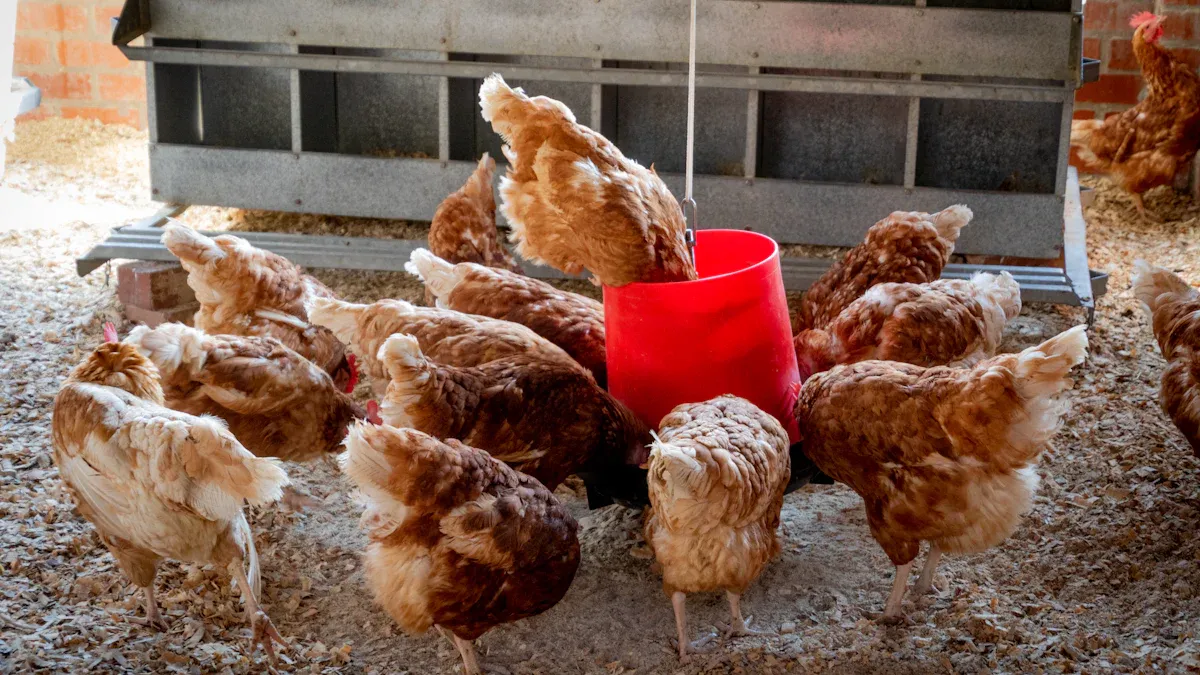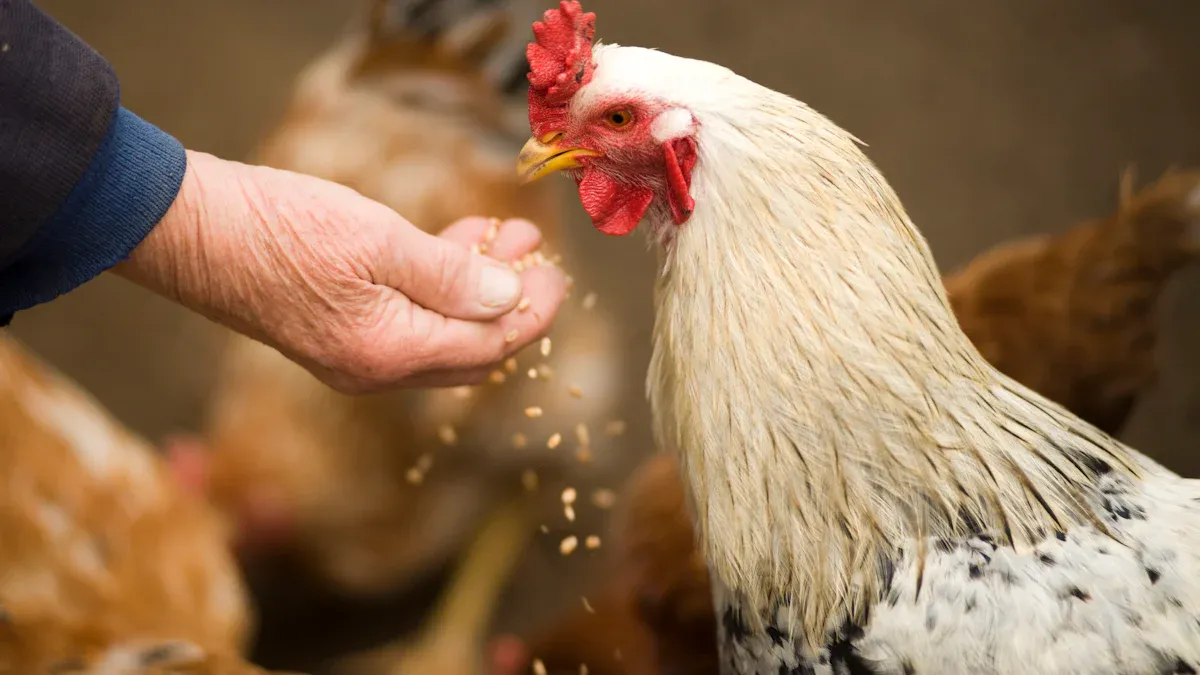
Sustainable farming is gaining momentum in the UK. Organic markets grew by 12.6% in 2020, reflecting this shift. Farmers are exploring innovative solutions like mealworms. These high protein mealworms offer a nutritious, eco-friendly feed option for chickens. They also reduce greenhouse gas emissions and require less land, making them a treat for mealworms enthusiasts.
Key Takeaways
- Mealworms are a protein-rich and healthy food for chickens.
- They help chickens grow better and lay more eggs.
- Using mealworms saves water and land, helping the environment.
- Farmers can grow mealworms with food scraps, reducing waste.
Environmental and Nutritional Benefits of High Protein Mealworms

Protein-Rich Nutrition for Chickens
Mealworms pack a punch when it comes to nutrition. They are rich in protein, which is essential for healthy chicken growth and egg production. Compared to traditional chicken feed like soybean meal, mealworms offer higher protein content. Here’s a quick comparison:
| Source | Protein Content (g/100g) |
|---|---|
| Mealworms | 13.68 – 22.32 |
| Traditional Chicken Feed (e.g., Soybean Meal) | Typically lower than mealworms |
Farmers are starting to notice these benefits. Studies show that over two-thirds of small-scale poultry farmers are open to using yellow mealworms as a protein source. Younger farmers, especially those aged 18-45, are more likely to adopt this innovative feed. This shift could revolutionize poultry farming by providing chickens with a healthier, more sustainable diet.
Efficient Resource Usage and Reduced Environmental Impact
Mealworms are not just nutritious—they’re also eco-friendly. Raising mealworms requires significantly less water and land compared to traditional livestock feed. For instance:
- The water footprint per edible ton of mealworms is 4341 m³/t, which is 3.5 times lower than beef.
- Mealworms thrive on organic food waste, reducing the need for additional agricultural resources.
By switching to mealworms, farmers can cut down on greenhouse gas emissions and conserve valuable resources. This makes mealworms a sustainable choice for the future of poultry farming.
Contribution to Waste Management and Circular Agriculture
Mealworm farming plays a key role in waste management and circular agriculture. These insects can be cultivated using organic waste, turning leftovers into high-quality chicken feed. Additionally, mealworms produce fewer greenhouse gases like CO2 and methane compared to traditional livestock. Here’s how they contribute:
| Evidence Type | Description |
|---|---|
| Greenhouse Gas Emissions | Mealworms emit significantly lower amounts of ammonia and greenhouse gases. |
| Land Use Efficiency | They require less land to produce 1 kg of edible protein than livestock. |
| Nutritional Value | Mealworms match livestock in nutrition while being more sustainable. |
Farmers in regions like South Africa have already shown interest in adopting mealworms. This trend could reduce reliance on less sustainable feed sources like soybean meal and fishmeal, paving the way for a greener agricultural system.
Practical Integration of Mealworms in Poultry Farming
Feeding Practices and System Adaptation
Farmers are finding creative ways to include mealworms in their poultry feeding systems. Younger farmers, especially those aged 18–45, are leading this shift. They see mealworms as a cost-effective and sustainable alternative to traditional feeds like soybean meal and fishmeal. Many farmers who already use mixed corn in their feeding practices are more open to trying mealworms. This flexibility makes it easier to adapt existing systems without significant changes.
Mealworms also offer economic benefits. Studies suggest that using them as a protein source can improve the profitability of small-scale poultry farming. However, some farmers have raised concerns about microbial safety. Addressing these issues through proper processing and quality control can help build trust and encourage wider adoption.
Land and Water Efficiency in Mealworm Farming
Mealworms are champions of efficiency when it comes to land and water use. Here’s how they compare to traditional livestock:
- Producing 1 kg of fresh mealworms requires much less land than beef or pork.
- Their feed conversion efficiency matches poultry, while their nitrogen use efficiency surpasses traditional livestock.
- Mealworms need significantly less water to produce edible protein compared to crops like soybeans.
These advantages make mealworms an eco-friendly choice for farmers looking to reduce their environmental footprint.
Cultivating Mealworms Using Organic Waste
Mealworms thrive on organic waste, turning leftovers into valuable chicken feed. This approach not only reduces food waste but also supports sustainable farming practices. The benefits of cultivating mealworms on organic waste include:
| Benefit | Description |
|---|---|
| Sustainability | Mealworms can be grown on food scraps, cutting down reliance on traditional feed sources. |
| Feed Conversion Efficiency | They require less land and water compared to crops like soybeans. |
| Nutritional Value | Mealworms provide essential nutrients like protein, amino acids, and vitamins for poultry. |
By using organic waste, farmers can create a circular agricultural system that minimizes waste and maximizes efficiency. This innovative approach aligns with the growing demand for sustainable farming solutions.
Regulatory Landscape and Industry Support
Current Regulations on Insect-Based Feeds
The regulatory framework for insect-based feeds in the UK is evolving. As of 2020, certain insect species, including mealworms, have been approved for human consumption. This approval aligns with European Union regulations, which are being updated to ensure hygiene standards for insects used in food and feed. These regulations are critical for promoting the safe use of insect-based feeds like high protein mealworms in poultry farming.
Europe leads the way in insect farming, with countries like the Netherlands and France producing insects for both human and animal consumption. The UK, as part of this broader market, has significant potential to expand its insect-based feed industry. However, clear guidelines and support are essential to encourage farmers to adopt these innovative feed options.
Addressing Farmer Concerns and Adoption Barriers
Farmers have shown interest in mealworms but also raised concerns about safety. Microorganisms like Spiroplasma and Erwinia in mealworms could pose risks if proper food safety measures aren’t followed. Younger farmers, aged 18-45, are more open to adopting mealworms compared to older generations. This generational gap highlights the need for education and outreach to address misconceptions.
Farmers also evaluate new technologies differently than scientists. This disconnect can slow adoption, especially without a clear regulatory framework. Building trust through transparent guidelines and quality assurance can help overcome these barriers.
FAQ
What makes mealworms a sustainable chicken feed option?
Mealworms require less land and water than traditional feed. They thrive on organic waste, reducing food waste and supporting circular agriculture. 🌱
Are mealworms safe for chickens?
Yes, mealworms are safe when properly processed. Quality control ensures they meet safety standards, addressing concerns about microorganisms like Spiroplasma.
How can farmers start using mealworms as feed?
Farmers can mix mealworms with existing feed like corn. They can also cultivate mealworms using organic waste for a cost-effective and eco-friendly solution.


